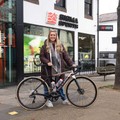When commuting by bike, there are some key accessories that will enhance comfort and safety. Read our guide to discover more about what you need, including mudguards, bags, tools and bike locks.
Getting to your destination, be that your place of work or study, with everything you need for the day and having enjoyed some fresh air and exercise on the way, is what commuting by bike should be all about.
Basics required for your ride include mudguards, a bag for carrying clothes, a computer and other items for the day, tools to fix mechanicals and a lock to secure your bike. Here at Sigma Sports we stock a large selection of essentials and have experts available in-store and online to provide you with advice.

Mudguards
If you’re planning on riding to work through the winter or even on damp summer days, then a good set of mudguards is going to be high up the shopping list. Wet roads are actually the biggest culprit when it comes to giving you a soaking, not rain itself, so fit some guards so you don’t arrive soggy and cold.
Full-length Mudguards
Offering the best coverage and protection for you, the bike and those riding behind you. Mounting can be complex, but once fitted they’re very sturdy. They will only fit if you have eyelets, plus clearance under the brakes (if rim brakes) and behind the seat tube. They often come with a rubber flap that attaches to the lower end of the mudguard to extend protection.
Clip-on Mudguards
Ideal for any bike that doesn’t have specific eyelets or the clearance for full guards. There are plenty of options, some of which still create a very effective barrier. They tend to be lighter than full guards and can be swapped between bikes, but compatibility can be an issue so it’s wise to check thoroughly before purchasing.
Mountain Bike-style Mudguards
Fewer compatibility issues than clip-ons, so they are good for bikes with fat tyres and various suspension setups, as well as for classic commuting style bikes. However, they provide limited protection. A range of sizes are available, they’re super quick to fit and even the smallest, ass-saver style guard will get you through a short wet commute without getting absolutely drenched.
What type of mudguards should I choose?
Which mudguards you need will very much depend on the bike they are being fitted to. You may have eyelets or hidden mounts, and if you do, you should go for full-length guards. If not, select the best clip-ons that fit your bike type, wheel size and tyre width.

Luggage
Luggage comes in all shapes and sizes but what you need on a daily basis will determine what’s best. You’re likely to be carrying more than you would on a weekend ride; maybe a laptop, a change of clothes, tools and possibly a lock, so comfort is essential and some of these items will require protection against any inclement weather. Small items may fit in jersey pockets or a saddle bag, but for most, something bigger is required. Your bike may limit your options too so take this into consideration.
Backpack
Good stability and ventilation, protective padding and a waterproof construction are things to look out for. Weight is also important, especially if you’re already going to be carrying heavy loads. A backpack is very simple and convenient but can start to make your shoulders and back ache on longer rides, and you may turn up to your destination sweaty, so work out whether it’s the best for you.
Messenger Bag
Slung over one shoulder, these bags are normally used by couriers and are good for lighter items, but they are less stable than a backpack and have a tendency to slip around to the side. They are light though and work well off the bike too, and you can load and unload one without taking it off.
Bikepacking Bags
Coming in all shapes and sizes, bags designed for bikepacking duties offer versatile, durable, weatherproof storage. They may be awkward for some of your kit however, fixing to the handlebar, frame or top tube, but if they work for your requirements, they are easy to fit and are compatible with most bikes.
Panniers
For bigger loads, panniers on racks are the most common solution. Most frequently attached to the rear, but also available for fork fitment, these bags take the weight off your back, but do add extra to your bike. Spacious and a good shape for computers and paperwork, most will have a weatherproof, durable construction. They’re highly stable and can be used as a pair or on just one side, and some have straps so they can be used like a backpack or messenger bag once off the bike. You do need a bike with mounting points for the rack though.
What luggage is best for me?
For lighter, smaller loads that you’re happy to carry on your back, choose a backpack or messenger bag. If you’re keen to take the load off your person, choose bikepacking bags or, if your bike has mounting points, panniers.

Tools
Multitool
A good multitool provides you with what you need for common roadside repairs so it’s a very worthwhile item to have. They vary in size and functionality, from the most basic with just a few Allen keys to those also featuring screwdrivers, a Torx key, a chain tool, tyre levers and spoke wrenches. Generally fairly small, it should fit easily in a pocket, saddle bag or rucksack, ready for when you need it.

Puncture Repair Kit
You should always carry everything required to fix a puncture at the side of the road. So either a puncture repair kit or spare inner tube (or both), tyre levers and a pump (see below). If you run your tyres tubeless you should also have a tubeless repair kit handy. There are tonnes of options out there but remember to consider tyre size, tyre width and rim depth when selecting an inner tube for the job.

Pump
Mini pumps and frame pumps are both suitable options for the commute. Both should come with a bracket for attaching to the water bottle bosses or frame, but if you’re planning on carrying it in a bag then a mini pump may be a better choice. The advantage of a frame pump is inflation efficiency but there are plenty of smaller pocket-friendly options that do a good job too. Some may have gauges, making it easier to see how much air is in the tyre, and some are hybrids, allowing you to also attach a CO2 canister for faster inflation.

What tools do I need to carry?
As a minimum, a puncture repair kit or inner tube, plus a pump and tyre levers, should be carried at all times. A multitool allows you to deal with other mechanical issues, and the more complex the tool, the more problems you will be able to deal with at the side of the road.
Bike Locks
If you need to lock up your bike during work hours, either on the street or in a more private area, you’ll need a good bike lock. Good advice is to get the best lock you can afford, as the consequences of a cheap lock being cut can turn out to be far more costly.
What should I consider when choosing a bike lock?
There are a number of things to consider when it comes to choosing. Where will the bike be locked up? For how long? How far is your commute? Having your bike gone when you come to leave work is sure to ruin your day, so make sure it’s adequately protected to put your mind at rest.
Definitely an accessory worth investing in, a good lock will help deter attempted theft, and the Sold Secure ratings are a good place to start in terms of how effective a lock is against actual attack. If you have bike insurance, the company will normally specify a certain level (Silver or Gold) to validate your policy.
Think about your ride and whether you can leave your lock in place permanently or at work overnight. If you can’t, or if your job involves actively riding your bike and parking up in different locations, weight will be important, particularly on longer commutes.
What type of locks are available?
D-Locks and chains are a good place to start when higher security is needed, and although a quality chain may be harder to penetrate, they do tend to weigh a couple of kilograms. Adding an extra cable to a chain or D-lock is also wise, so you can lock the main frame and then loop the cable around wheels, saddle rails and anything else that needs securing. Some locks are designed to be worn or can be attached to the bike itself for easier, more comfortable commuting. Smaller and lighter but less secure cafe locks aren't designed for all-day security but can be handy if you're quickly popping into a shop or your bike is always within view.
Which bike lock should I choose?
Firstly, think about the value of your bike, and consider any insurance requirements (if applicable). Following this, go for the best lock you can, and use a cable in combination with the main lock to secure wheels and saddle in addition to the main frame.

Don't leave home without the above items and you'll not only have more enjoyable, more comfortable commutes, but you'll also have peace of mind about the security of your bike throughout the day. We stock plenty of other accessories too, to further enhance the experience.






